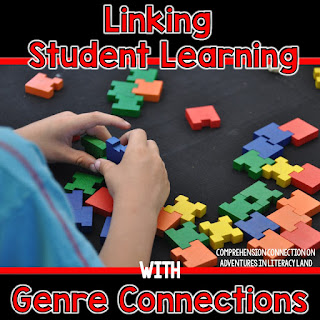Comprehension Connections and Genre Connections by Tanny McGregor are two books every teacher needs to purchase, read, and keep for reference later. Both of these books are filled with lesson ideas to help your students become active thinkers in the reading process. Many kids just scratch the surface as they read often missing the subtleties that authors weave into their texts.
Today's post by Carla at Comprehension Connection will explain how these books can be used and add spark to your teaching and your students' learning experience. Read on to get more information...
Today's post by Carla at Comprehension Connection will explain how these books can be used and add spark to your teaching and your students' learning experience. Read on to get more information...
When Adventures in Literacy Land kicked off, my co-bloggers, Emily at Curious Firsties and Andrea from Reading Toward the Stars, wrote up posts related to Tanny McGregor's book, Comprehension Connections. They talked about lesson ideas they'd used from her book. I loved them, and decided I had to have my own copy of the book. I am really glad to have discovered it as Tanny's hands-on approach and higher level thinking skills help students who need just a little more in depth explanation of skills get what they need.
 Another important concept from Comprehension Connections is using a launching sequence similar to the gradual release model. The added benefit of the launching sequence is that it includes the use of various sensory stimuli such as music, wordless picture books, and art to scaffold the important points of the lesson and to reach those learners who prefer a hands-on approach. I particularly love Tanny’s ideas because we need our students to think critically about their reading, and as the launching sequence is implemented, students analyze, question, and connect.
Another important concept from Comprehension Connections is using a launching sequence similar to the gradual release model. The added benefit of the launching sequence is that it includes the use of various sensory stimuli such as music, wordless picture books, and art to scaffold the important points of the lesson and to reach those learners who prefer a hands-on approach. I particularly love Tanny’s ideas because we need our students to think critically about their reading, and as the launching sequence is implemented, students analyze, question, and connect. In Comprehension Connections, the chapters each focus on a different comprehension skill. This is very helpful as teachers can quickly skim each chapter for a quick idea or to spark one of their own. Certainly, all of the ideas can be applied to different books and learning levels, and in fact, we know multiple opportunities for students to practice a skill is essential for students to transfer that learning into independent practice. Therefore, multiple lessons are required for mastery.
Now, before I transition to Genre Connections, I have a question for our readers.
 Like the launching sequence in Comprehension Connections, students begin these lessons with a concrete object. The concrete objects are chosen to help the student realize purpose for the learning and categorize information to more firmly differentiate genres. Tanny calls this process, “Noticing and Naming the Genre.” She uses simple objects that are readily available such as clothespins, prisms (in your science kits), mirrors, and one of my favorites, seed packets.
Like the launching sequence in Comprehension Connections, students begin these lessons with a concrete object. The concrete objects are chosen to help the student realize purpose for the learning and categorize information to more firmly differentiate genres. Tanny calls this process, “Noticing and Naming the Genre.” She uses simple objects that are readily available such as clothespins, prisms (in your science kits), mirrors, and one of my favorites, seed packets. In the section about informational text, she uses seed packets to get students to notice information we can learn from small bits of text if we're observant. Just look for a minute at this image and think about all the information you can gather...price, what vegetable will look like, name of the produce, how and when to plant it (notice the headings), who produced the seeds, and even the year the seeds were made for. We need our students to read informational text like a gardener reads seed packets. We need them to realize that informational text includes certain features not found in other genres.
Another option is to use artwork that explains such as the examples in this Prezi file.
 Once students have explored various sensory media and inferred how we read informational text and what features we expect to find, then an anchor chart similar to this one would provide students with the opportunity to think how reading the seed packet relates to future reading of informational text. I also loved [this handout] from Dana Herzog which would be very helpful for interactive notebooks or future mini lessons.
Once students have explored various sensory media and inferred how we read informational text and what features we expect to find, then an anchor chart similar to this one would provide students with the opportunity to think how reading the seed packet relates to future reading of informational text. I also loved [this handout] from Dana Herzog which would be very helpful for interactive notebooks or future mini lessons.Now, it's your turn. What concrete objects would you choose to launch genre studies or improve reading comprehension?
Please share what's worked well for you.








I think I will need to go and purchase this book. She is an amazing author!! Her ideas are spot on!
ReplyDeleteThanks for this post!
em
Definitely do. I think knowing your teaching style, Em...you'll love it.
DeleteCarla
What grade level are the books focused on? I love the ideas but am wondering about adaptation to upper elementary.
ReplyDeleteAll of the ideas are easily adapted to upper grades. Genre Connections is geared to upper elementary. There are also great ideas for all grade levels. They are both definitely worth the read!
DeleteAndrea